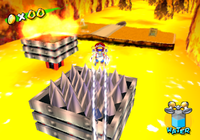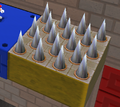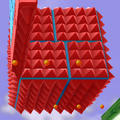Spike Trap: Difference between revisions
mNo edit summary |
(did what i could. the super mario series needs to be written to how it's like in super mario run) |
||
| Line 3: | Line 3: | ||
{{about|the common obstacle|other uses of the word "spike"|[[Spike (disambiguation)]]}} | {{about|the common obstacle|other uses of the word "spike"|[[Spike (disambiguation)]]}} | ||
[[File:SMS spikes.png|thumb|right|Spike Traps in [[Corona Mountain]] in ''Super Mario Sunshine''.]] | [[File:SMS spikes.png|thumb|right|Spike Traps in [[Corona Mountain]] in ''Super Mario Sunshine''.]] | ||
'''Spike Traps''' (or simply '''Spikes''', sometimes '''Spiked Platform'''<ref>Hodgson, David S J, Bryan Stratton, and Stephen Stratton. ''Super Mario Sunshine'' [[Prima Games|Prima]] Official Strategy Guide. Page 15.</ref> or '''Spiked Floor'''<ref>von Esmarch, Nick, and Cory van Grier. ''Donkey Kong Country: Tropical Freeze'' [[Prima Games|Prima]] Official Game Guide. Page 26.</ref>) are harmful objects that can power down | '''Spike Traps''' (or simply '''Spikes''', sometimes '''Spiked Platform'''<ref>Hodgson, David S J, Bryan Stratton, and Stephen Stratton. ''Super Mario Sunshine'' [[Prima Games|Prima]] Official Strategy Guide. Page 15.</ref> or '''Spiked Floor'''<ref>von Esmarch, Nick, and Cory van Grier. ''Donkey Kong Country: Tropical Freeze'' [[Prima Games|Prima]] Official Game Guide. Page 26.</ref>) are harmful objects that can power down characters, cause them to lose health, or even lose lives. These traps appear in nearly all ''[[Mario (franchise)|Mario]]'' games. Spike Traps tend to be stationary, retractable, or attached to a moving object. They are first introduced in ''[[Super Mario Bros. 2]]'', though [[Icicle]]s in ''[[Mario Bros. (game)|Mario Bros.]]'' are functionally the same until they fall. | ||
==History== | |||
===''Super Mario'' series=== | |||
In ''Super Mario Bros. 2'', riding an [[Autobomb]] was mandatory in order to cross the spike traps in some levels. | In ''Super Mario Bros. 2'', riding an [[Autobomb]] was mandatory in order to cross the spike traps in some levels. | ||
In ''[[Super Mario Bros. 3]]'', wearing a [[Goomba's Shoe]] | In ''[[Super Mario Bros. 3]]'', wearing a [[Goomba's Shoe]] allows Mario or Luigi to easily hop across spikes.' | ||
''[[ | In ''[[Super Mario World]]'', Yoshi can safely walk on spike traps. This game also introduces the [[Falling Spike]]. | ||
In ''[[Super Mario | In ''[[Super Mario Galaxy]]'' and ''[[Super Mario Galaxy 2]]'', [[Mario]] or [[Luigi]] run uncontrollably if they do come into contact with a spike trap. | ||
In ''[[Super Mario 3D Land]]'', spikes often appear as spinning spiked balls attached to a block (in a similar fashion to [[Fire Bar]]s) known as [[Spike Bar]]s and as stationery spiked blocks. Retractable floor spikes similar to those present in ''Super Mario Galaxy 2'' appear as well. | In ''[[Super Mario 3D Land]]'', spikes often appear as spinning spiked balls attached to a block (in a similar fashion to [[Fire Bar]]s) known as [[Spike Bar]]s and as stationery spiked blocks. Retractable floor spikes similar to those present in ''Super Mario Galaxy 2'' appear as well. | ||
In ''[[Super Mario Maker]]'' and ''[[Super Mario Maker for Nintendo 3DS]]'', Spike Traps also appear as objects. They can damage Mario if he touches them, and are classified as block objects. Depending on the game style and theme, Spike Traps can change appearance, most notably in the ''Super Mario Bros. 3'' and ''Super Mario World'' game styles, where in the underwater theme, the Spike Trap will either change into a [[Jelectro]], or a [[zeldawiki:Sea Urchin|Sea Urchin]] from ''[[zeldawiki:The Legend of Zelda: Link's Awakening|The Legend of Zelda: Link's Awakening]]''. Additionally, shaking a Spike Trap in the ''New Super Mario Bros. U'' ground theme makes a train sound.<ref>GameXplain. April 4, 2016. [https://www.youtube.com/watch?v=EToxTmkrbkk Train Whistle SECRET in Super Mario Maker]. ''YouTube''. Retrieved May 18, 2016.</ref> | ===''Yoshi'' series=== | ||
In ''[[Super Mario World 2: Yoshi's Island]]'', ''[[Yoshi's Island: Super Mario Advance 3]]'', ''[[Yoshi's Island DS]]'', ''[[Yoshi's New Island]]'', and ''[[Yoshi's Woolly World]]'', spikes are a lot more fatal than in the ''Super Mario'' series titles, as simply touching them will cause a [[Yoshi (species)|Yoshi]] to lose a life instantly. A more common rough object, a [[thorn]], also appears in the ''Yoshi's Island'' series. | |||
''[[Yoshi's Story]]'' features living, jumping [[Spike (Yoshi's Story)|Spike]]s in [[Bone Dragon Pit]] and [[Magma Castle]]. | |||
===''Super Mario Maker''=== | |||
In ''[[Super Mario Maker]]'' and ''[[Super Mario Maker for Nintendo 3DS|its port]]'', Spike Traps also appear as objects. They can damage Mario if he touches them, and are classified as block objects. Depending on the game style and theme, Spike Traps can change appearance, most notably in the ''Super Mario Bros. 3'' and ''Super Mario World'' game styles, where in the underwater theme, the Spike Trap will either change into a [[Jelectro]], or a [[zeldawiki:Sea Urchin|Sea Urchin]] from ''[[zeldawiki:The Legend of Zelda: Link's Awakening|The Legend of Zelda: Link's Awakening]]''. Additionally, shaking a Spike Trap in the ''New Super Mario Bros. U'' ground theme makes a train sound.<ref>GameXplain. April 4, 2016. [https://www.youtube.com/watch?v=EToxTmkrbkk Train Whistle SECRET in Super Mario Maker]. ''YouTube''. Retrieved May 18, 2016.</ref> | |||
===''Paper Mario: Color Splash''=== | |||
Spikes appear in ''[[Paper Mario: Color Splash]]''. Spike pits appear in levels such as [[Mustard Café]], [[The Golden Coliseum]], and [[Fortune Island]]. 8-bit spikes appear in [[Green Energy Plant]]. In [[Kiwano Temple]], many spikes that resemble [[Spiny Shell]]s appear. Some must be crossed by rolling platforms, and others must be flipped over with a [[POW Block]]. | Spikes appear in ''[[Paper Mario: Color Splash]]''. Spike pits appear in levels such as [[Mustard Café]], [[The Golden Coliseum]], and [[Fortune Island]]. 8-bit spikes appear in [[Green Energy Plant]]. In [[Kiwano Temple]], many spikes that resemble [[Spiny Shell]]s appear. Some must be crossed by rolling platforms, and others must be flipped over with a [[POW Block]]. | ||
===''Super Mario Run''=== | |||
Spike Traps reappear in ''[[Super Mario Run]],'' making their first appearance in the level [[Shell Me the Way!]] when collecting the [[Black Coin]]s. They have the same appearance as the Spike Traps in the ''New Super Mario Bros. U'' style of ''Super Mario Maker''.<ref>[https://www.youtube.com/watch?v=YoPcRYxdFB4]</ref> | Spike Traps reappear in ''[[Super Mario Run]],'' making their first appearance in the level [[Shell Me the Way!]] when collecting the [[Black Coin]]s. They have the same appearance as the Spike Traps in the ''New Super Mario Bros. U'' style of ''Super Mario Maker''.<ref>[https://www.youtube.com/watch?v=YoPcRYxdFB4]</ref> | ||
{{br}} | {{br}} | ||
Revision as of 19:20, May 19, 2018

|
This article has been chosen to be a focus for this month's edition of The 'Shroom Spotlight. Be sure to read about our goals for the article, and help to contribute in any way that you can. |
It has been requested that this article be rewritten. Reason: Very messy, and some tense troubles (tagged on October 25, 2017)
- This article is about the common obstacle. For other uses of the word "spike", see Spike (disambiguation).

Spike Traps (or simply Spikes, sometimes Spiked Platform[1] or Spiked Floor[2]) are harmful objects that can power down characters, cause them to lose health, or even lose lives. These traps appear in nearly all Mario games. Spike Traps tend to be stationary, retractable, or attached to a moving object. They are first introduced in Super Mario Bros. 2, though Icicles in Mario Bros. are functionally the same until they fall.
History
Super Mario series
In Super Mario Bros. 2, riding an Autobomb was mandatory in order to cross the spike traps in some levels.
In Super Mario Bros. 3, wearing a Goomba's Shoe allows Mario or Luigi to easily hop across spikes.'
In Super Mario World, Yoshi can safely walk on spike traps. This game also introduces the Falling Spike.
In Super Mario Galaxy and Super Mario Galaxy 2, Mario or Luigi run uncontrollably if they do come into contact with a spike trap.
In Super Mario 3D Land, spikes often appear as spinning spiked balls attached to a block (in a similar fashion to Fire Bars) known as Spike Bars and as stationery spiked blocks. Retractable floor spikes similar to those present in Super Mario Galaxy 2 appear as well.
Yoshi series
In Super Mario World 2: Yoshi's Island, Yoshi's Island: Super Mario Advance 3, Yoshi's Island DS, Yoshi's New Island, and Yoshi's Woolly World, spikes are a lot more fatal than in the Super Mario series titles, as simply touching them will cause a Yoshi to lose a life instantly. A more common rough object, a thorn, also appears in the Yoshi's Island series.
Yoshi's Story features living, jumping Spikes in Bone Dragon Pit and Magma Castle.
Super Mario Maker
In Super Mario Maker and its port, Spike Traps also appear as objects. They can damage Mario if he touches them, and are classified as block objects. Depending on the game style and theme, Spike Traps can change appearance, most notably in the Super Mario Bros. 3 and Super Mario World game styles, where in the underwater theme, the Spike Trap will either change into a Jelectro, or a Sea Urchin from The Legend of Zelda: Link's Awakening. Additionally, shaking a Spike Trap in the New Super Mario Bros. U ground theme makes a train sound.[3]
Paper Mario: Color Splash
Spikes appear in Paper Mario: Color Splash. Spike pits appear in levels such as Mustard Café, The Golden Coliseum, and Fortune Island. 8-bit spikes appear in Green Energy Plant. In Kiwano Temple, many spikes that resemble Spiny Shells appear. Some must be crossed by rolling platforms, and others must be flipped over with a POW Block.
Super Mario Run
Spike Traps reappear in Super Mario Run, making their first appearance in the level Shell Me the Way! when collecting the Black Coins. They have the same appearance as the Spike Traps in the New Super Mario Bros. U style of Super Mario Maker.[4]
Gallery
- Yellow spikes YI.PNG
Spikes in Flip-Out Galaxy in Super Mario Galaxy 2.
Multi-surface spikes that appear only in the Flipsville Galaxy.
Super Mario Maker
(Super Mario Bros.)
Names in other languages
| Language | Name | Meaning |
|---|---|---|
| Japanese | トゲ[5] Toge トゲブロック[6] Toge Block トゲ床[7] Toge Yuka |
Spike Spike Block Spike Platform |
| Portuguese | Armadilha Espinhosa |
Spiked Trap |
| Spanish | Trampa Espinosa |
Spiky Trap |
References
- ^ Hodgson, David S J, Bryan Stratton, and Stephen Stratton. Super Mario Sunshine Prima Official Strategy Guide. Page 15.
- ^ von Esmarch, Nick, and Cory van Grier. Donkey Kong Country: Tropical Freeze Prima Official Game Guide. Page 26.
- ^ GameXplain. April 4, 2016. Train Whistle SECRET in Super Mario Maker. YouTube. Retrieved May 18, 2016.
- ^ [1]
- ^ Shogakukan. 2015. Super Mario Bros. Hyakka: Nintendo Kōshiki Guidebook, pages 41, 61, 78, 105, 119, 150, 200.
- ^ Mario & Wario instruction booklet, page 9.
- ^ Shogakukan. 2015. Super Mario Bros. Hyakka: Nintendo Kōshiki Guidebook, pages 170, 186, 233.
- Traps and Obstacles
- Mario & Wario
- Mario vs. Donkey Kong Objects
- Mini Mario & Friends: amiibo Challenge Objects
- New Super Mario Bros. Objects
- New Super Mario Bros. 2 Objects
- New Super Mario Bros. U Objects
- New Super Mario Bros. Wii Objects
- Paper Mario: Sticker Star Objects
- Paper Mario: Color Splash Objects
- Super Mario Advance Objects
- Super Mario Advance 4: Super Mario Bros. 3 Objects
- Super Mario Bros. 2 Objects
- Super Mario Bros. 3 Objects
- Super Mario Galaxy 2 Objects
- Super Mario Maker Objects
- Super Mario Sunshine Objects
- Super Mario Odyssey Objects
- Super Mario World Objects
- Super Mario World 2: Yoshi's Island Objects
- Super Paper Mario Objects
- Wario Land: Super Mario Land 3 Objects
- Wario Land II Objects
- Yoshi Topsy-Turvy Objects
- Yoshi's Island DS Objects
- Yoshi's Island: Super Mario Advance 3
- Yoshi's New Island Objects
- Yoshi's Story Objects
- Yoshi's Woolly World Objects







